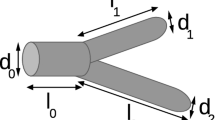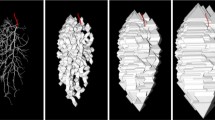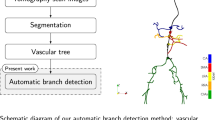Abstract
There is a paucity of data on the branching pattern and dimensions of the blood vessels in various organs. The reason for the paucity is undoubtedly the tremendous effort needed to obtain the morphometric data. For those organs whose morphometric data have been determined, pruning was introduced: cutting off branches at succesive generations, measuring what remained, using the statistical data to estimate what were cut off, and adding the estimated data to the measured data to obtain the final results. Evaluation of the effects of pruning was not possible, however, because a full set of precise data did not exist. Now a complete set of morphometric data on the coronary arteries is presented by Kassabet al. (8). Hence we are in a position to evaluate pruningversus accuracy. Among several pruning protocols tried we found a simple, easy-to-follow scheme that seemed to be reasonable. It reduced the labor by 79% when it was applied to the left anterior descending (LAD) artery of the pig, and it caused the following percentage errors based on comparison with the unpruned data. The largest error incurred in the mean diameters of all orders of tree is 7.6%. The corresponding maximum errors in the length and number of elements in all orders are −9.8% and 30.0%, respectively. The estimated error of the total equivalent Poiseuille's resistance for the LAD artery computed from pruned data was 25.2% when compared with that computed from unpruned data.
Similar content being viewed by others
References
Fung, Y.C. Biodynamics: Circulation. New York: Springer-Verlag; 1984.
Gan, R.Z.; Tian, Y.; Yen, R.T.; Kassab, G.S. Morphometry of the dog pulmonary venous tree. J. Appl. Physiol. 75(1):432–440; 1993.
Horsfield, K.; Cumming, G. Morphology of the bronchial tree in man. J. Appl. Physiol. 24:373–383; 1968.
Horsfield, K.; Gordon, W.I. Morphometry of pulmonary veins in man. Lung 159:211–218; 1981.
Horton, R.E. Erosional development of streams and their drainage basins: hydrophysical approach to quantitative morphology. Bull. Geol. Soc. Amer. 56:275–370; 1945.
Jiang, Z.L.; Kassab, G.S.; Fung, Y.C. Diameter-defined Strahler system and connectivity matrix of the pulmonary arterial tree. J. Appl. Physiol. 76(2):882–892; 1994.
Kassab, G.S. Morphometry of the coronary arteries in the pig. Ph.D. thesis. La Jolla: University of California, San Diego; 1990.
Kassab, G.S.; Rider, C.A.; Tang, N.J.; Fung, Y.-C. Morphometry of pig coronary arterial trees. Am. J. Physiol. 265(Heart Circ. Physiol. 34):H350-H365; 1993.
Kassab, G.S.; Lin, D.H.; Fung, Y.C. Morphometry of pig coronary venous system. Am. J. Physiol. In press.
Kassab, G.S.; Imoto, K.; White, F.C.; Rider, C.A.; Fung, Y.-C.; Bloor, C.M. Coronary arterial tree remodeling in right ventricular hypertrophy. Am. J. Physiol. 265(Heart Circ. Physiol. 34):H366-H375; 1993.
Mandelbrot, B.B. The fractal geometry of nature. New York: Freeman; 1983.
Singhal, S.; Henderson, R.; Horsfield, K.; Harding, K.; Cumming, G. Morphometry of the human pulmonary arterial tree. Circ. Res. 23:190–197; 1973.
Strahler, A.N. Hyposometric (area altitude) analysis of erosional topology. Bull. Geol. Soc. Amer. 63:1117–1142; 1952.
VanBavel, E.; Spaan, J.A.E. Branching patterns in the porcine coronary arterial tree: estimation of flow heterogeneity. Circ. Res. 71:1200–1212, 1992.
Weibel, E.R. Design of airways and blood vessels considered as branching trees. In: Crystal, R.G.; West, J.B.; Barnes, P.J.; Cherniak, N.S.; Weibel, E.R., eds. The lung: scientific foundations. New York: Raven Press, 1991: pp. 771–720.
Weibel, E.R. Morphometry of the human lung. Heidelberg: Springer Verlag, 1963.
Yeh, H.C.; Schum, G.M.; Duggan, M.T. Anatomic models of the tracheobronchial and pulmonary regions of the rat. Anat. Rec. 195:483–492; 1979.
Yen, R.T.; Zhuang, F.Y.; Fung, Y.C.; Ho, H.H.; Tremer, H.; Sobin, S.S. Morphometry of cat's pulmonary arterial tree. J. Biomech. Eng. 106:131–136; 1984.
Yen, R.T.; Zhuang, F.Y.; Fung, Y.C.; Ho, H.H.; Tremer, H.; Sobin, S.S. Morphometry of the cat's pulmonary venous tree. J. Appl. Physiol. 55:236–242; 1983.
Zhuang, F.Y.; Fung, Y.C.; Yen, R.T. Analysis of blood flow in cat's lung with detailed anatomical and elasticity data. J. Appl. Physiol. 55(4):1341–1348; 1983.
Author information
Authors and Affiliations
Rights and permissions
About this article
Cite this article
Kassab, G.S., Lin, D.H. & Fung, YC.B. Consequences of pruning in morphometry of coronary vasculature. Ann Biomed Eng 22, 398–403 (1994). https://doi.org/10.1007/BF02368246
Received:
Revised:
Accepted:
Issue Date:
DOI: https://doi.org/10.1007/BF02368246




